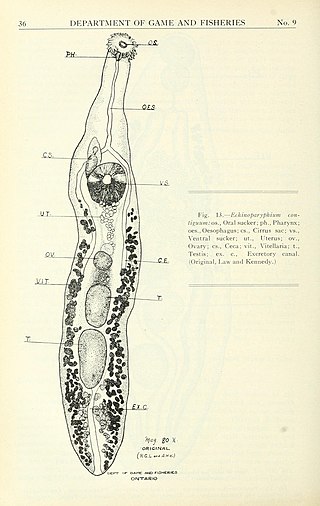Related Research Articles

Trematoda is a class of flatworms known as flukes or trematodes. They are obligate internal parasites with a complex life cycle requiring at least two hosts. The intermediate host, in which asexual reproduction occurs, is usually a snail. The definitive host, where the flukes sexually reproduce, is a vertebrate. Infection by trematodes can cause disease in all five traditional vertebrate classes: mammals, birds, amphibians, reptiles, and fish.

Echinostoma is a genus of trematodes (flukes), which can infect both humans and other animals. These intestinal flukes have a three-host life cycle with snails or other aquatic organisms as intermediate hosts, and a variety of animals, including humans, as their definitive hosts.

Leucochloridium paradoxum, the green-banded broodsac, is a parasitic flatworm. Its intermediate hosts are land snails, usually of the genus Succinea. The pulsating, green broodsacs fill the eye stalks of the snail, thereby attracting predation by birds, the primary host. These broodsacs visually imitate caterpillars, a prey of birds. The adult parasite lives in the bird's cloaca, releasing its eggs into the faeces.

Lymnaea stagnalis, better known as the great pond snail, is a species of large air-breathing freshwater snail, an aquatic pulmonate gastropod mollusk in the family Lymnaeidae. The great pond snail is a model organism to study parasitology, neurology, embryonal development and genetic regulation.

Lithoglyphus naticoides, the gravel snail, is a species of small or minute freshwater snail with an operculum, an aquatic gastropod mollusk in the family Lithoglyphidae.

Ponticola kessleri, the bighead goby or Kessler's goby, is a species of goby native to Eurasia. The bighead goby is a Ponto-Caspian relict species. It inhabits the fresh and oligohaline waters, with mineralisation from 0–0.5‰ up to 1.5–3.0‰.
Metagonimoides oregonensis is a trematode, or fluke worm, in the family Heterophyidae. This North American parasite is found primarily in the intestines of raccoons, American minks, frogs in the genus Rana, and freshwater snails in the genus Goniobasis. It was first described in 1931 by E. W. Price. The parasite has a large distribution, from Oregon to North Carolina. Adult flukes vary in host range and morphology dependent on the geographical location. This results in different life cycles, as well as intermediate hosts, across the United States. On the west coast, the intermediate host is freshwater snails (Goniobasis), while on the east coast the intermediate host is salamanders (Desmognathus). The parasites on the west coast are generally much larger than on the east coast. For example, the pharynx as well as the body of the parasite are distinctly larger in Oregon than in North Carolina. The reverse pattern is observed on the east coast for uterine eggs, which are larger on the west coast. In snails, there is also a higher rate of infection in female snails than in males. Research on the life history traits of the parasites have been performed with hamsters and frogs as model species.

Leucochloridium variae, the brown-banded broodsac, is a species of trematode whose life cycle involves the alternate parasitic infection of certain species of snail and bird. While there is no external evidence of the worm's existence within the bird host, the infection of the snail host is visible when its eye stalks become grotesquely engorged with the parasite's brood sacs. These brood sacks pulsate and move to imitate insect larva, attracting the parasite's next host, insectivore birds. The bird rips off the eye stalk and eats it, thus becoming infected. Later on, the parasite's eggs are dropped with the bird's feces. Similar life-histories are found in other species of the genus Leucochloridium, including Leucochloridium paradoxum.
Echinostoma cinetorchis is a species of human intestinal fluke, a trematode in the family Echinostomatidae.
Plagioporus skrjabini is a species of a trematode in the family Opecoelidae.

Opecoelidae is a family of trematodes. It is the largest digenean family with over 90 genera and nearly 900 species, almost solely found in marine and freshwater teleost fishes. It was considered by Bray et al. to belong in the superfamily Opecoeloidea Ozaki, 1925 or the Brachycladioidea Odhner, 1905.

Metagonimus yokogawai, or the Yokogawa fluke, is a species of a trematode, or fluke worm, in the family Heterophyidae.

Hamacreadium is a genus of trematodes in the family Opecoelidae. It is synonymous with Olivacreadium Bilqees, 1976. Species of Hamacreadium are endoparasitic in fish such as Lethrinus Cuvier, 1829.
Diplostomum pseudospathaceum is a species of trematode in the family Diplostomidae.
Allopodocotyle is a genus of trematodes in the family Opecoelidae.
Cainocreadium is a genus of trematodes in the family Opecoelidae. It has been synonymised with Apopodocotyle Pritchard, 1966, Cainocreadoides Nagaty, 1956, and Emmettrema Caballero y Caballero, 1946.
Decemtestis is a genus of trematodes in the family Opecoelidae. It has been synonymised with Allodecemtestis Hafeezullah, 1970.
Neonotoporus is a genus of trematodes in the family Opecoelidae.
Stenakron is a genus of trematodes in the family Opecoelidae.

Echinoparyphium is a genus of trematodes. Intermediate hosts include snails, bivalves and fish. Definitive hosts are mainly birds and mammals.
References
- 1 2 3 4 5 6 Zhokhov A. E., Molodozhnikova N. M. & Pugacheva M. N. (2006). "Dispersal of invading trematodes Nicolla skrjabini (Iwanitzky, 1928) and Plagioporus skrjabini Kowal, 1951 (Trematoda: Opecoelidae) in the Volga". Russian Journal of Ecology 37(5): 363-365. doi : 10.1134/S1067413606050110.
- 1 2 Tyutin A. V. & Slynko Yu. V. (2010). "The first finding of the Black Sea snail Lithoglyphus naticoides (Gastropoda) and its associated species-specific trematoda in the Upper Volga basin". Russian Journal of Biological Invasions 1(1): 45-49. doi : 10.1134/S2075111710010091.